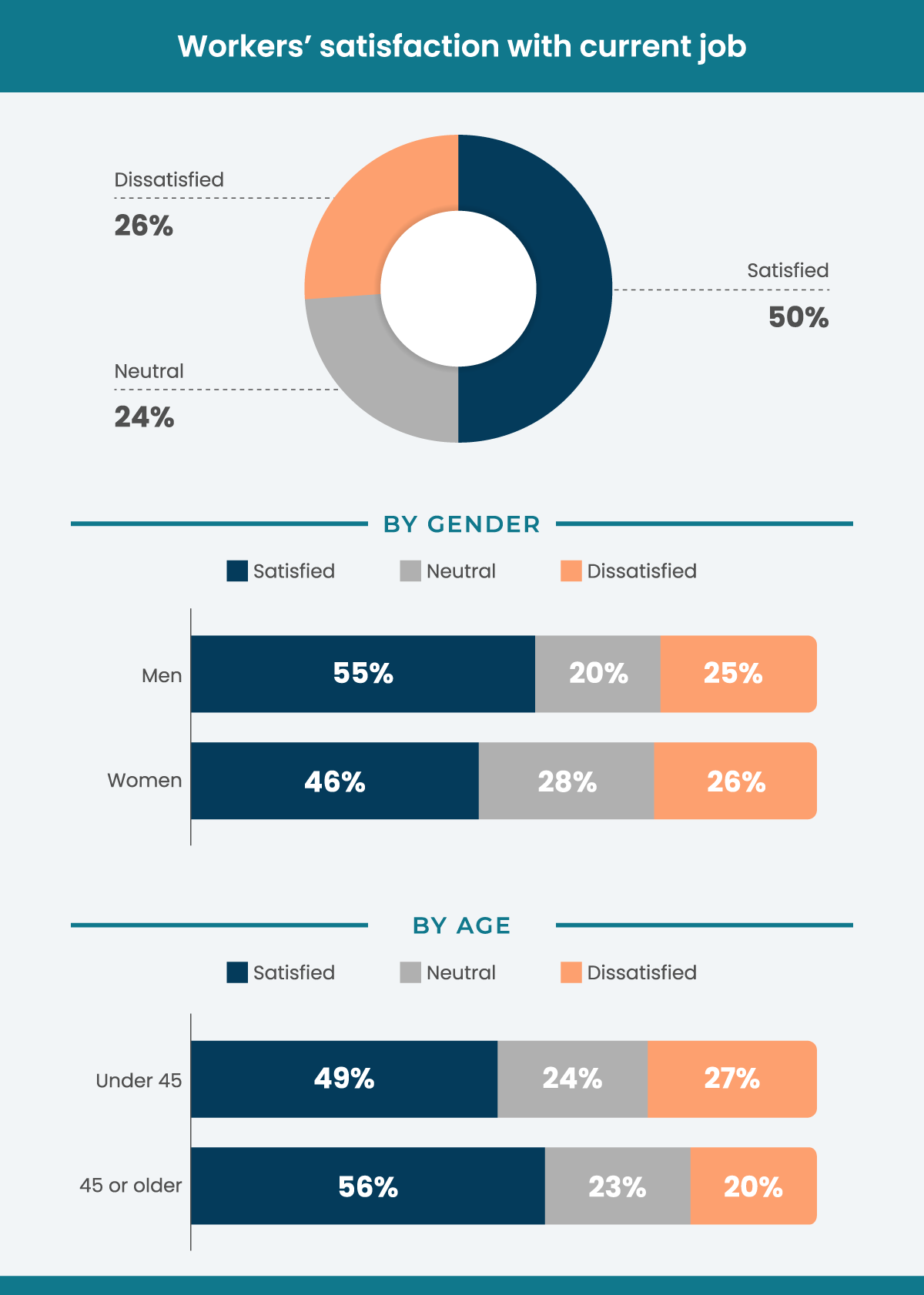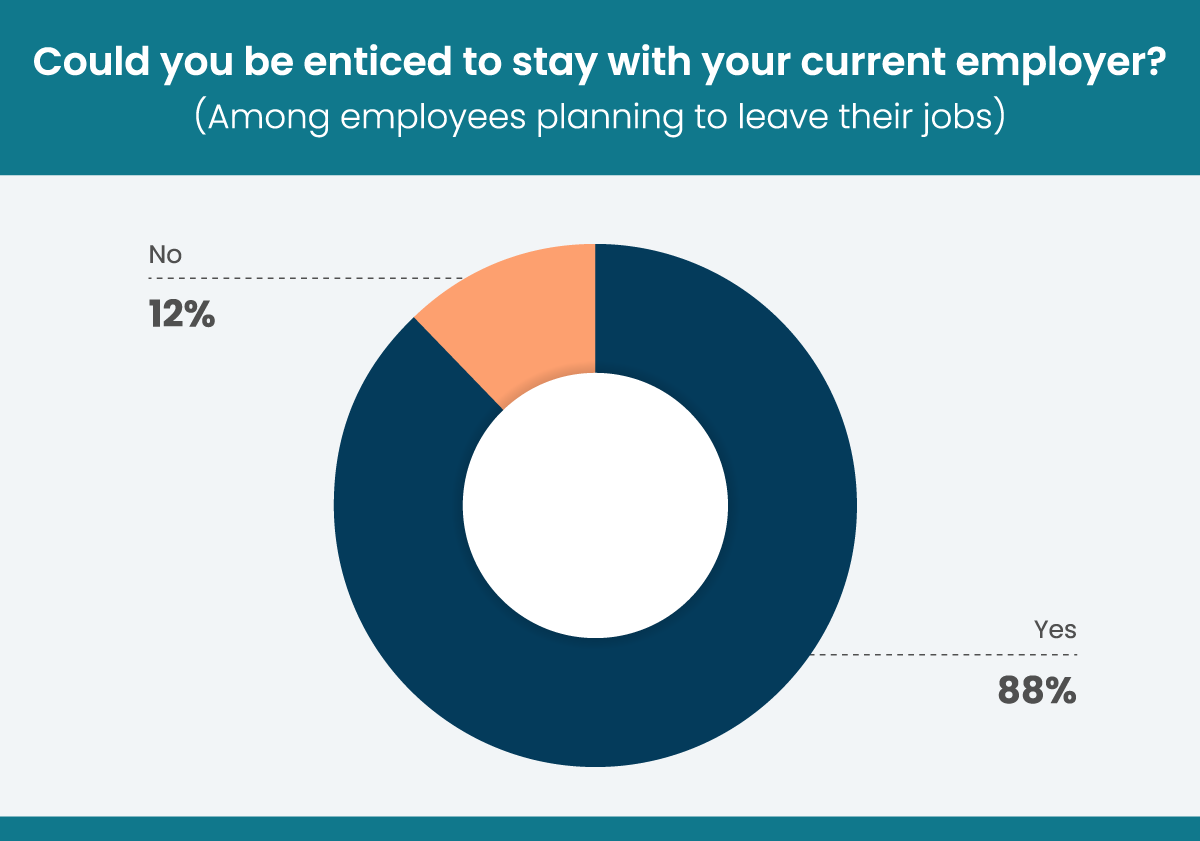Public health crises past and present have caused labor shortages that ripped out and reworked the fabric of society. The Great Plague liberated serfs, the Spanish Flu brought women to the workplace, and COVID-19 is empowering modern employees to redefine work-life balance and find roles that fit their lifestyles.
In upending the economy, the coronavirus also reshaped views of the workforce. Hourly earners were finally seen as essential and many office workers logged in from home, while government assistance allowed millions to reconsider their employment status. Many workers delayed their returns to the office or quit their jobs to seek more favorable terms as part of The Great Resignation.
Now low unemployment and rising wages have made good workers harder to hire. Our new research into what American workers need to stay on the job revealed a workforce in turmoil, with many employees dissatisfied and actively looking for new positions. Specifically, our study of workers and job seekers found:
- Fifty percent of working Americans are not satisfied in their current positions.
- Only 36 percent of American workers believe they’re compensated fairly and 31 percent feel they are doing meaningful work.
- More than 60 percent of those currently employed are seeking new jobs or will start searching within the next six months. However, better pay would entice three-quarters of those planning to leave their jobs to stay.
- Workers who lack competitive pay, meaningful work, or appreciation from their colleagues and leaders are most likely to be searching for new jobs.
About one in three employees now consider remote working and flexible scheduling options essential for job satisfaction. Sixty-four percent of workers without remote work options are looking for new jobs.
Pandemic of unhappiness: job satisfaction proves elusive for American workers
Grumbling about one’s paycheck or boss is a classic workplace pastime, but current complaints carry a far deeper gravity. It appears that COVID-19’s disruption allowed many Americans to evaluate their careers, and many disliked what they found.
Overall, only half of workers are satisfied with their current jobs. Another quarter are neutral, and 26 percent are dissatisfied.
Levels of satisfaction varied moderately by gender and age, with women less satisfied with their jobs than are men, and older employees more content than younger ones. The demographic factor most aligned with worker morale was income: employee satisfaction rates were highest among those with the highest salaries.
Yet money alone cannot buy happiness or employee satisfaction. The workers in our study also cited time off, health insurance, schedule flexibility, and positive environment among the most important factors for job satisfaction.
>Which of the following benefits are most important for job satisfaction? | |||
| Competitive pay | 60% | Retirement plans | 16% |
| Health insurance | 46% | Bonuses/profit sharing | 14% |
| Paid leave/vacation | 44% | Training opportunities | 11% |
| Remote work options | 34% | Unlimited time off | 8% |
| Meaningful and satisfying work | 34% | Mental health support | 6% |
| Flexible scheduling | 33% | Tuition reimbursement | 4% |
| Paid sick time | 29% | Regular feedback | 4% |
| 401(k) matching | 24% | Student loan reimbursement | 3% |
| Promotion/growth potential | 24% | Free food | 3% |
| Feeling valued by leaders or colleagues | 23% | Maternity/paternity Leave | 3% |
| Opportunities to learn new skills and gain experience | 21% | Company discounts | 3% |
| Company culture | 19% | Childcare assistance | 2% |
Note: Up to 5 choices allowed
Competitive pay was most important of all, followed by health insurance and paid vacations. Meaningful work also proved influential, along with remote work options – an undeniable legacy of pandemic adjustments.
Unfortunately, these perks prove scarce in today’s workplace, especially for women. Just over one in three employees believe they receive competitive pay and even fewer have meaningful work. Only three of the ten most important criteria for employee satisfaction are present in most positions.
>Which of the following benefits do you currently have at work? | |||
| All workers | Men | Women | |
| Health insurance | 58% | 61% | 56% |
| Paid vacation | 55% | 60% | 50% |
| Paid sick time | 51% | 51% | 50% |
| 401(k) matching | 44% | 48% | 39% |
| Remote work options | 38% | 40% | 35% |
| Competitive pay | 36% | 42% | 30% |
| Flexible scheduling | 36% | 34% | 38% |
| Meaningful and satisfying work | 31% | 31% | 31% |
| Promotion or growth potential | 30% | 32% | 27% |
| Feeling valued by leaders or colleagues | 30% | 27% | 34% |
The absence of such qualities has a measurable effect on job satisfaction. Employees enjoying competitive pay, meaningful work, or growth potential were at least twice as likely to be satisfied as those lacking such benefits. Similar drops in satisfaction were noted among those doing without any of the most desirable benefits.
Benefits and job satisfaction
>Percentage satisfied with current job, by whether or not they have certain benefits | ||
| Those with benefit | Those without benefit | |
| Competitive pay | 77% | 35% |
| Meaningful and satisfying work | 79% | 37% |
| Promotion or growth potential | 77% | 39% |
| Flexible scheduling | 62% | 43% |
| Health insurance | 58% | 40% |
| Paid leave/vacation | 58% | 41% |
| Remote work options | 61% | 44% |
| Paid sick time | 58% | 42% |
| 401(k) Matching | 58% | 44% |
This epidemic of dissatisfaction is not irreversible – nearly two-thirds of respondents offered specific suggestions that would improve their workplace contentment. The most common requests were better pay, more benefits, and remote working options, but also included pleas for cultural improvements like better communication and a greater appreciation of efforts.
Companies that fail to make such improvements are destined to lose dissatisfied employees, with many already looking to make their exits.
High turnover rates likely to continue
Even the most apathetic employers can hold onto staff in tight labor markets, but plentiful jobs create competition for firms in need of workers. Unemployment may soon drop below 3%, supplying Americans with wider employment options – and our analysis found that many are looking for a change.
More than 60 percent of those currently employed are seeking new jobs or will start searching within the next six months.
These numbers also differ noticeably by gender and age. Though men receive more pay and report greater job satisfaction than women, they are still more likely to be on the hunt for new roles. Older employees are less likely to be searching for new roles compared to younger professionals.
Those looking elsewhere most commonly cited financial reasons, but career opportunities proved nearly as impactful.
>Reasons workers are looking for new jobs | |
| Dissatisfaction with pay | 57% |
| Seeking career development opportunities | 55% |
| Issues with company culture or work environment | 38% |
| Personal life changes (moving, going back to school, etc.) | 24% |
Note: Multiple responses allowed
These motivations were consistent across demographics, though older employees focused more intently on money and culture while younger workers were more often driven by a desire to improve their careers.
Correlating missing benefits to job hunting activity revealed some specific issues fueling workers’ departures. Seventy-three percent of those who feel underpaid are planning to change jobs, compared to 61 percent of all workers. That number is nearly as high for workers who feel they lack meaningful work or appreciation from their team members.
>Missing benefits most likely to drive turnover | |
| Deficiency at current job | Percent looking for a new job |
| Lack of competitive pay | 73% |
| Lack of meaningful and satisfying work | 72% |
| Not feeling valued by leaders or colleagues | 71% |
| No health insurance | 70% |
| No paid leave/vacation | 70% |
| No paid sick time | 69% |
| No 401(k) matching | 68% |
| Little promotion/growth potential | 68% |
| Insufficient remote work options | 64% |
| Inflexible scheduling | 64% |
Note: Includes responses from those currently looking for a new job or planning to do so in the 6 months
With so many already fishing for better gigs, can employers sweeten their bait to keep current workers hooked?
Turning resignations into retention
Retaining good workers helps companies maintain consistency, preserve institutional knowledge, and avoid the inherent costs of bad hires. Fortunately, responsive businesses still have a chance to hold together dissatisfied teams during the Great Resignation.
Among workers looking to leave their current positions, an overwhelming majority suggested their employers could convince them to stay.
Asked how they might be convinced to remain, answers again fell into broad categories. Better pay was the clear winner, suggesting that more intangible improvements aren’t as effective once employees have moved towards the door.
>What could your company offer that would entice you to stay in your current position? | |
| Increased compensation | 74% |
| Improved company culture, working environment | 33% |
| Better prospects for career improvement | 17% |
| Providing additional benefits | 14% |
Note: Among those who could be enticed to stay. Multiple responses allowed.
Conclusion
When workers are plentiful and openings scarce, employers suppress wages knowing paychecks are precious. That is the nature of capitalism. When tables turn and positions are unfilled, workers hold the upper hand. That is the situation of the current post-COVID economy.
Quarantine conditions changed employee expectations and redefined workers' primary needs. In addition to fair pay, Americans now place greater value on flexible hours, remote working options, and performing meaningful work in the quest for a healthier work-life balance. Low unemployment provides leverage to make such demands, and the ability to quit or change jobs if refused.
With companies already increasing incentives and escalating benefits to keep workers, this research supplies a blueprint for success. In addition to money and benefits, employers should prioritize corporate culture, adjust office paradigms, and offer clear career paths to proactively promote worker satisfaction. Dissatisfied workers are far more likely to stray and become more expensive to retain or replace.
Our data
Business.com conducted two online surveys regarding employment experiences, expectations, and satisfaction in February of 2022, involving 991 American adults. 76 percent of respondents were employed full or part-time, 18 percent were unemployed at the time but seeking new jobs, and the remainder were students, retirees, or others looking to (re)enter the workforce. Approximately 50 percent of participants were male and 50 percent were female. 236 were between the ages of 18-24, 367 were aged 25-34, 236 were aged 35-44, 89 were aged 45-54 and 63 participants were 55 years of age or older.



